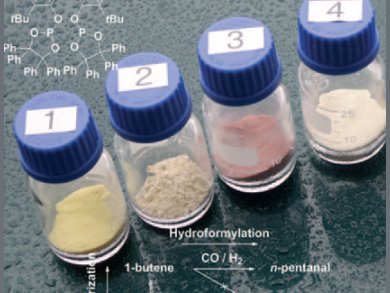Hydroformylation is one of the largest applications of homogeneous catalysis in industry. Immobilization of the catalyst would facilitate the isolation of the products. To this end, the continuous gas-phase hydroformylation of pure 1-alkene feedstocks has been developed with a catalyst dispersed in a thin film of ionic liquid physisorbed on the surface of a porous solid.
Peter Wasserscheid and colleagues, Friedrich-Alexander-Universität Erlangen-Nürnberg, Germany, have now extended this concept to an industrial mixed C4 feedstock by including highly active and selective diphosphite ligands.
CO and H2 are selectively added to 1-butene, but 2-butenes and the large quantity of isobutene (43.1 % of the feedstock mixture) remain untouched. This gives a remarkable selectivity of 99 % n-pentanal. The catalyst is stable for more than 800 h on stream making it relevant for industrial use.
Image: A selection of the supported catalysts developed. (c) Wiley-VCH
- Rhodium–Phosphite SILP Catalysis for the Highly Selective Hydroformylation of Mixed C4 Feedstocks
M. Jakuttis, A. Schönweiz, S. Werner, R. Franke, K.-D. Wiese, M. Haumann, P. Wasserscheid,
Angew. Chem. Int. Ed. 2011.
DOI: 10.1002/anie.201007164




